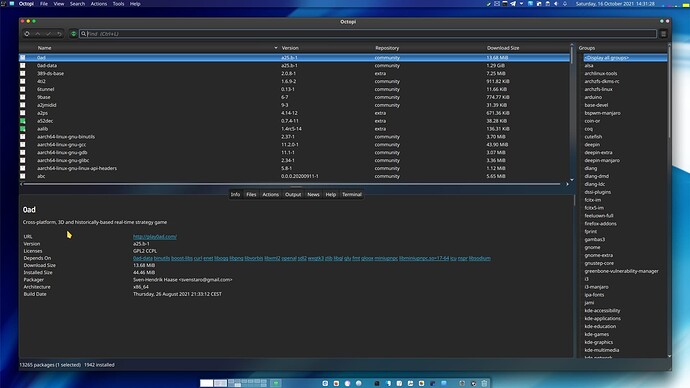Now that everyone’s had their say and that the usual doses of unwarranted mud have been slung back and forth ─ you’ve all kept the mod team quite busy at cleaning up this thread  ─ here’s how yours truly uses the AUR…
─ here’s how yours truly uses the AUR…
If there is a need for me to search whether a package exists in the AUR ─ which usually means that a newbie is asking about a certain functionality that’s not offered by anything in the Manjaro repositories ─ then I open up Octopi.
As mentioned by @openminded higher up this thread, if you type something in the Octopi search field on account of the AUR, then you have to explicitly hit Enter, and you also first have to enable the AUR search by clicking this button below… 

Now, as for searching for updates to the AUR software I have installed, I only do this whenever there is an actual Manjaro update. So I update my Manjaro system first ─ with pacman, from the command line, while completely logged out of my desktop environment ─ and then I will check for AUR updates afterwards with… 
yay -Syu --aur --devel
Yes, I know that I can use yay for doing Manjaro updates as well, but I have to become root anyway in order to remount several of my read-only filesystems as read/write first before trying to update anything, so I might as well run pacman right away.
Anyway, this only happens on average about twice a month. And when there is nothing from the AUR requiring an update, then I just leave it at that until the next Manjaro update comes along. “If it ain’t broke, don’t fix it.”
The only time I ever fire up Pamac ─ or at least, its GUI ─ is when there’s a newbie who has a problem with it and I need to verify that for myself.
That said, the Pamac GUI is pretty much unusable for me anyway, because it somehow doesn’t like the colors of my chosen GTK theme, and therefore I cannot read what it shows me ─ white text on a white background in certain parts of the GUI. But I don’t care, because I simply have no need for it.
Do I need to know the name of a package? Octopi will tell me all I need to know. Do I need to install software? The command line, while completely logged out of the GUI, is the ultimate way to go. No conflicting situations due to libraries that are in use while they are being overwritten, no interfering processes, and I can easily clean up the cache afterwards.
And, I get to see everything that the package manager is doing, because it’s all scrolling by on the tty. It’ll tell me when there’s a .pacnew file, or when something is installed that has a new optional dependency, or if there’s an issue with the permissions set in the package differing from the permissions set in my filesystems, and so on.
And now that I’m busy ranting, here’s what I think… Too many people are lacking the patience for properly using this distribution, or even GNU/Linux as a whole. And to us moderators ─ and even to our TL3 and TL4 members ─ this becomes very evident whenever there’s some new issue introduced with an update, because…
-
First it’ll be reported on the update announcement thread ─ several times, because the people reporting it can’t be bothered reading the whole thread; and…
-
Then it’ll be reported on a dozen new and independently posted threads, because the people reporting it can’t be bothered reading the update announcement thread ─ where both the issue and the fix for it may have already been posted by @philm in the second post on the thread ─ plus that they also can’t be bothered using the forum’s search function to see whether someone else has also already reported the issue.
It’s all about “me, me, me, me”. You even see this in some of the thread titles themselves ─ “Please help me!!!”. Why does that need to be added to the thread title?! If you’re going to post about a problem with a GNU/Linux distribution on said distribution’s support forum, then doesn’t that imply already that you need help? Or are you adding that to your thread title so as to tell us to drop all assistance we’re providing to our other members just so as to come to the rescue of Your Royal Highness?
And it gets even worse, because some people expect that help to arrive right after posting their thread. If they don’t get a reply within the first 15 minutes, they’ll just post a new thread about the same thing, and/or they’ll even start spamming other people’s threads with their problem.
People can’t even be bothered posting their threads in the proper forum category. Only a few days ago I had to move a thread about problems with Nvidia graphics adapters and multiple monitors out of the #support:network category. I kid you not. 
Likewise, those of our members who prefer posting in another language than English can’t be bothered to post in the respective category for their language. Strangely enough, their English is good enough to pick a forum category from the list, but not good enough to recognize their own language among the forum categories. 
Yes, the Pamac GUI has a problem in its code base ─ not a coding bug, but a design bug, which causes problems for the people running the AUR servers ─ and this bug will be dealt with. But the biggest problem is the loose nut between the keyboard and the chair, with their lack of a sense of responsibility, a short or non-existing attention span, intellectual laziness and ─ above all ─ selfishness.
And then I’m not even getting into the newbies who come here with an attitude and a sense of entitlement, demanding to be helped right away, and showing a complete lack of respect for whoever attempts to help them ─ even if it’s a staff member or a Manjaro developer.
Hell, we’ve even got complete newbies signing up here and then spamming the #site-feedback category with how they think Manjaro should be put together, all the while not even knowing the distinction between the work done by the Manjaro developers and packages from upstream, or even from the AUR. They don’t even understand that GNU/Linux is not Microsoft Windows.
The bottom line of this long rant is that what Manjaro really needs right now is an attitude change among a large part of its user base, and especially among the vast majority of the newbies.
But hey, this thread is posted in the #support:aur section, so the newbies won’t get to see it. They don’t even see that huge search box. All they see is that + button for posting a new thread.

</end rant>
P.S.: All those of you with an inclination for slinging mud around and going ad hominem had better start biting their tongue. It takes only two mouse clicks to close this thread, and only a few more to send a couple of people on a short vacation.



